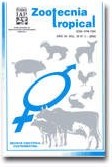
|
Zootecnia Tropical
Instituto Nacional de Investigaciones Agrícolas Venezuela
ISSN: 0798-7269
Vol. 27, No. 2, 2009, pp. 151-161
|
 Bioline Code: zt09018
Bioline Code: zt09018
Full paper language: Spanish
Document type: Research Article
Document available free of charge
|
|
|
Zootecnia Tropical, Vol. 27, No. 2, 2009, pp. 151-161
| en |
Effect of animal feeding on the microbiological quality of manures used as fertilizers
Espinoza, Yusmary; Hernández Z., Marcos J.; Barrera Ch., Teresa V. & Obispo, Néstor E.
Abstract
To evaluate the relationship between type of diet and microbiology quality of cow, hen, and pig manure used as
fertilizers, we collected samples of each manure (M) from farms located in Aragua, Carabobo, and Yaracuy states,
Venezuela. On the basis of a completely randomized experimental design with four repetitions, the following
treatments were compared: bovine (B), poultry (G), and pork (C) manures, in combination with two different
types of diets (D1 and D2) provided to the animals, for six treatments. Samples were processed and analyzed
for total bacteria and fungi contents, and total and fecal coliform bacteria. There was not a specific effect of the
type of diet on the number of bacteria and fungi among the manures. The higher content of bacteria and fungi
was observed in bovine and poultry manures, respectively. In general, the amount of fecal coliforms found in
the manures ranked between 2 x 106
to 7 x 107
MPN/g. These values exceed those values internationally allowed
for these pathogens in the manures used as fertilizers. Manures were grouped on the basis of their similarities of
microbial loads, pathogens or fertilizer conditions, in three well defined groups: I: BD1 and BD2, II: GD1, GD2
and CD1, and III: CD2. Group I, with less stable conditions, was associated to the mineralization and higher
number of bacteria. The second was more stable as organic fertilizer with lesser capacity to immobilize the N,
but with a high risk for the public health due to its high load of pathogens. The third group had the highest risk
for public health that compromises its use as organic fertilizer.
Keywords
manure, diet, feeding, quality, fertilizer
|
| |
| es |
Efecto de la alimentación animal sobre la calidad microbiológica de estiércoles usados como fertilizantes
Espinoza, Yusmary; Hernández Z., Marcos J.; Barrera Ch., Teresa V. & Obispo, Néstor E.
Resumen
Con la finalidad de evaluar la relación entre el tipo de dieta recibida por los animales sobre la calidad microbiológica
de las excretas de bovinos, aves y cerdos y su uso como fertilizantes, se recolectaron muestras de las correspondientes
excretas animales (EA), en granjas ubicadas en distintas localidades de los estados Aragua, Carabobo y Yaracuy.
En un diseño experimental completamente aleatorizado con cuatro repeticiones, se compararon los siguientes
tratamientos basados en tres tipos de excretas: vacuno o bosta (B), de gallina o gallinaza (G) y porcino o cerdaza
(C), en combinación con dos diferentes dietas alimenticias (D1 y D2), diferentes en cada caso, suministrados a los
animales. Se les determinó el contenido de bacterias y hongos totales, bacterias coliformes totales y fecales. No se
observó una respuesta concreta relacionada con la dieta sobre el número bacterias y hongos presentes en las EA
estudiadas. El mayor número de bacterias se encontró en la bosta y el mayor numero de hongos en la gallinaza.
En general, la cantidad de coliformes fecales, encontradas en las EA estudiadas, estuvo en el rango de 2 x 106
a
7 x 107
NMP/g. Estos valores excedieron los valores permitidos para estos patógenos en materiales orgánicos de
origen animal para su uso como fertilizantes orgánicos. La bosta con ambas dietas mostró tener el menor grado
de estabilización, determinada en base a la cantidad de C mineralizado. En base a las similitudes encontradas
entre las variables estudiadas, los tratamientos fueron agrupadas, mediante un análisis cluster, de acuerdo a sus
cargas microbianas, patógenos, o de condiciones de fertilización, encontrándose tres grupos claramente definidos:
Grupo I: BD1 y BD2; Grupo II: GD1, GD2 y CD1 y el Grupo III: CD2. El primer grupo tuvo una condición
menos estable asociado a la mineralización y aun mayor número de bacterias, el segundo fue estable como abono
orgánico y con capacidad para inmovilizar menor cantidad de N, pero con un alto riesgo para la salud pública por
su carga de patógenos. El tercer grupo, de altísimo riesgo para la salud pública, potencialmente lo cuestiona en
su uso como fertilizante orgánico.
Palabras-clave
estiércol, dieta, alimentación, calidad microbiológica, fertilizante orgánico
|
| |
© Copyright 2009 - Zootecnia Tropical
Alternative site location: http://www.sian.inia.gob.ve/repositorio/revistas_ci/ZootecniaTropical/ztindice.htm
|
|
